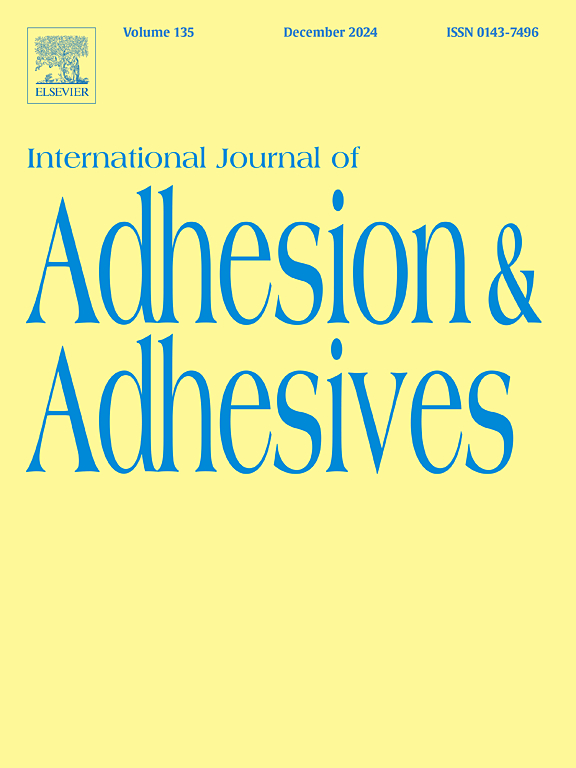Mechanical behavior of repaired resin composites, zirconia, and hybrid ceramics fabricated by additive and subtractive manufacturing technologies: An in vitro study
IF 3.5
3区 材料科学
Q2 ENGINEERING, CHEMICAL
International Journal of Adhesion and Adhesives
Pub Date : 2025-08-22
DOI:10.1016/j.ijadhadh.2025.104128
引用次数: 0
Abstract
The aim of this study was to evaluate the effects of substrate material and repair composite on surface wettability, shear‐bond strength (SBS), and interfacial stress distribution of direct repairs to digitally fabricated restorations. One hundred and twenty disk‐shaped specimens (Ø 10 × 2 mm) were divided into six substrate groups (n = 20): two additively manufactured resin composites (Crowntec, C; NextDent C&B, ND), two printed zirconias (LithaCon 3Y‐TZP, LI; INNI‐Cera 3Y‐TZP, IN) and two subtractively manufactured ceramics (Vita Enamic PICN, EN; IPS e.max ZirCAD MT, IPZ). Each group was repaired with either a microhybrid (Clearfil Majesty Esthetic, CL) or a nanofilled composite (Filtek Z350 XT, FZ; n = 10). Contact angles were measured post-conditioning via sessile drop. Specimens were thermocycled, then SBS was evaluated at 0.5 mm/min. Two-way ANOVA with Tukey post-hoc (α = 0.05) analyzed angle and SBS. Finite element analysis of a 200 N shear load mapped interfacial stress distributions. Contact angles ranged from 58.5 ± 6.1° (IN–FZ) to 71.2 ± 7.7° (C–CL), with significant effects of substrate (p = 0.018), composite (p = 0.041), and their interaction (p = 0.036). SBS was highest on IN (CL: 26.9 ± 4.0 MPa; FZ: 28.5 ± 3.6 MPa) and lowest on C (15.0 ± 2.0 MPa; 15.2 ± 1.8 MPa; p < 0.05). FZ tended toward higher SBS than CL, although within-substrate differences were non-significant. FEA revealed that FZ repairs produced more centralized tensile‐stress cores than CL repairs, and stiffer substrates (IPZ) showed higher compressive stresses. Both substrate and composite type significantly influence wettability, shear-bond strength, and interfacial stress distribution. Nanofilled composites paired with MDP‐based adhesives optimize repair performance on ceramic substrates.
添加剂和减法制造技术制备的修复树脂复合材料、氧化锆和杂化陶瓷的力学行为:体外研究
本研究的目的是评估基板材料和修复复合材料对数字制造修复体直接修复的表面润湿性、剪切结合强度(SBS)和界面应力分布的影响。120个盘形样品(Ø 10 × 2 mm)被分为6组基底(n = 20):两组增材制造树脂复合材料(Crowntec, C; NextDent C&;B, ND),两组印刷氧化锆(LithaCon 3Y‐TZP, LI; INNI‐Cera 3Y‐TZP, IN)和两组减法制造陶瓷(Vita Enamic PICN, EN; IPS e.max ZirCAD MT, IPZ)。每组均采用微复合材料(Clearfil Majesty aesthetics, CL)或纳米填充复合材料(Filtek Z350 XT, FZ; n = 10)进行修复。接触角测量后适应通过无柄滴。样品进行热循环,然后以0.5 mm/min的速度评估SBS。采用Tukey事后方差分析(α = 0.05)分析角度与SBS。200 N剪切载荷下的有限元分析界面应力分布图。接触角范围从58.5±6.1°(IN-FZ)到71.2±7.7°(C-CL),衬底(p = 0.018)、复合材料(p = 0.041)和相互作用(p = 0.036)对接触角有显著影响。SBS是最高的(CL: 26.9±4.0 MPa; FZ: 28.5±3.6 MPa)和最低C(15.0±2.0 MPa; 15.2±1.8 MPa; p & lt; 0.05)。FZ比CL倾向于更高的SBS,尽管底物内部差异不显著。有限元分析显示,FZ修复比CL修复产生了更集中的拉应力核心,更硬的基材(IPZ)显示出更高的压应力。基材和复合材料类型对润湿性、剪切结合强度和界面应力分布都有显著影响。纳米填充复合材料与MDP基粘合剂配对优化陶瓷基板的修复性能。
本文章由计算机程序翻译,如有差异,请以英文原文为准。
求助全文
约1分钟内获得全文
求助全文
来源期刊

International Journal of Adhesion and Adhesives
工程技术-材料科学:综合
CiteScore
6.90
自引率
8.80%
发文量
200
审稿时长
8.3 months
期刊介绍:
The International Journal of Adhesion and Adhesives draws together the many aspects of the science and technology of adhesive materials, from fundamental research and development work to industrial applications. Subject areas covered include: interfacial interactions, surface chemistry, methods of testing, accumulation of test data on physical and mechanical properties, environmental effects, new adhesive materials, sealants, design of bonded joints, and manufacturing technology.
 求助内容:
求助内容: 应助结果提醒方式:
应助结果提醒方式:


